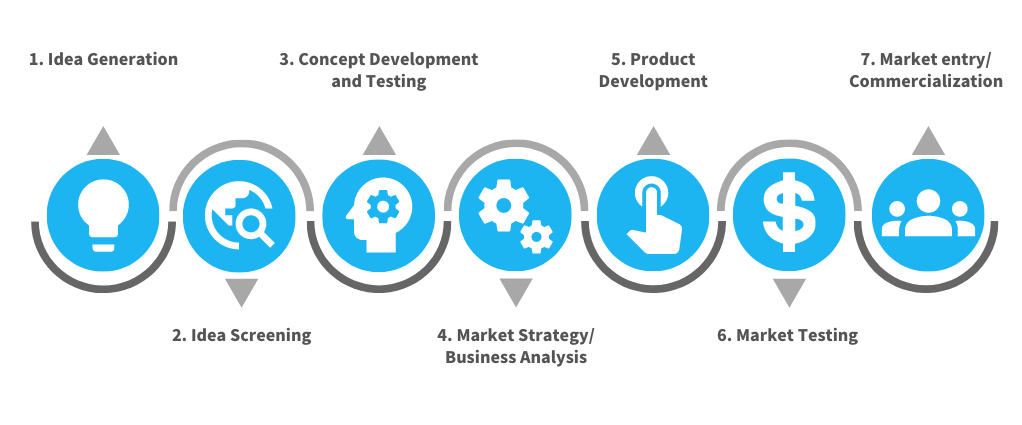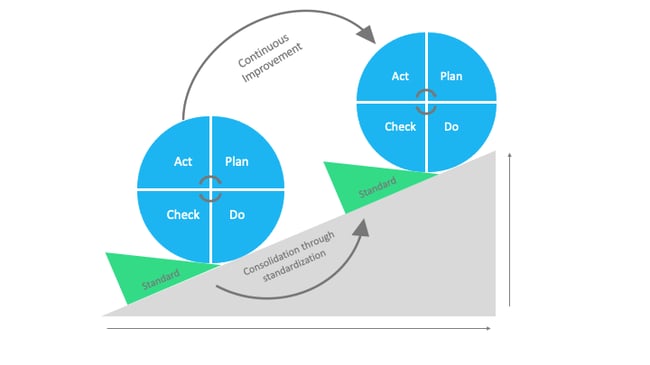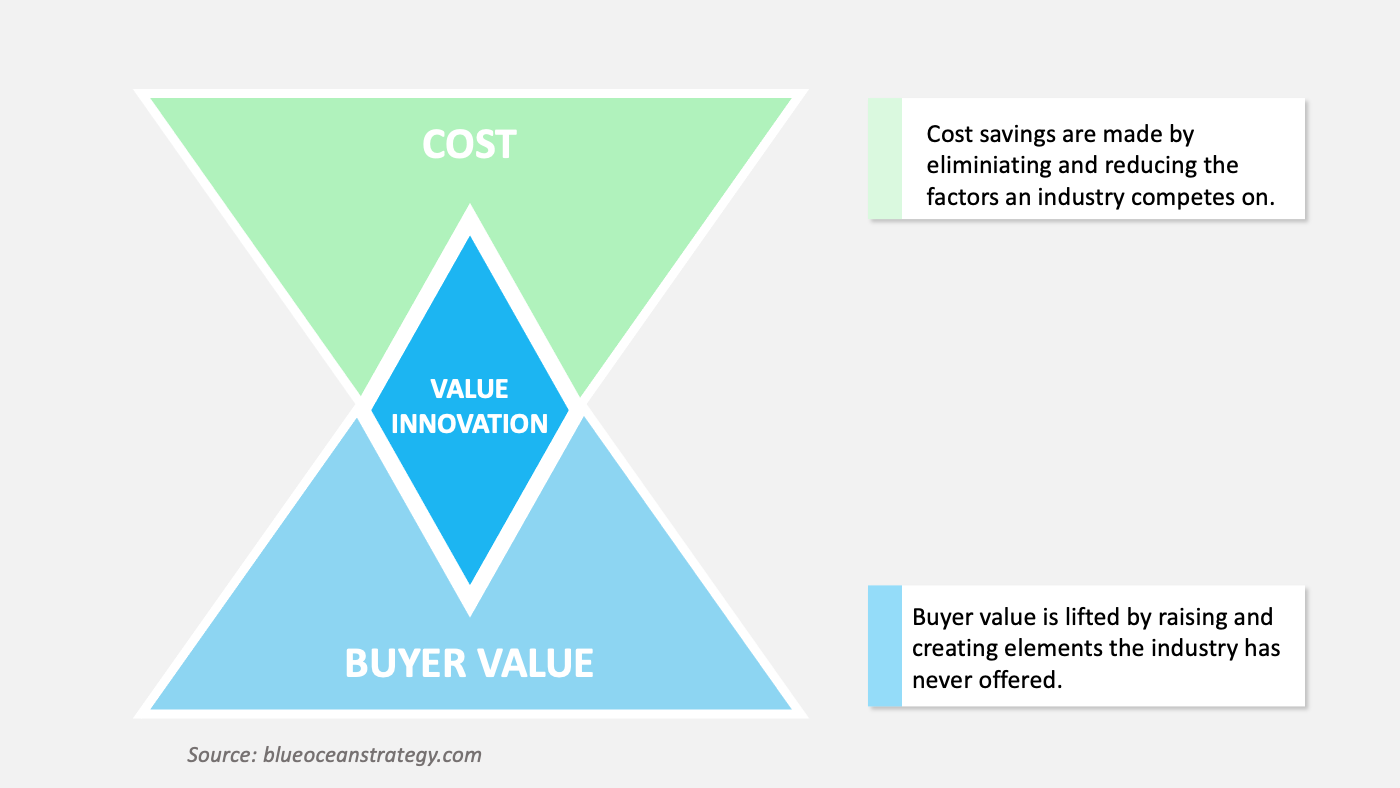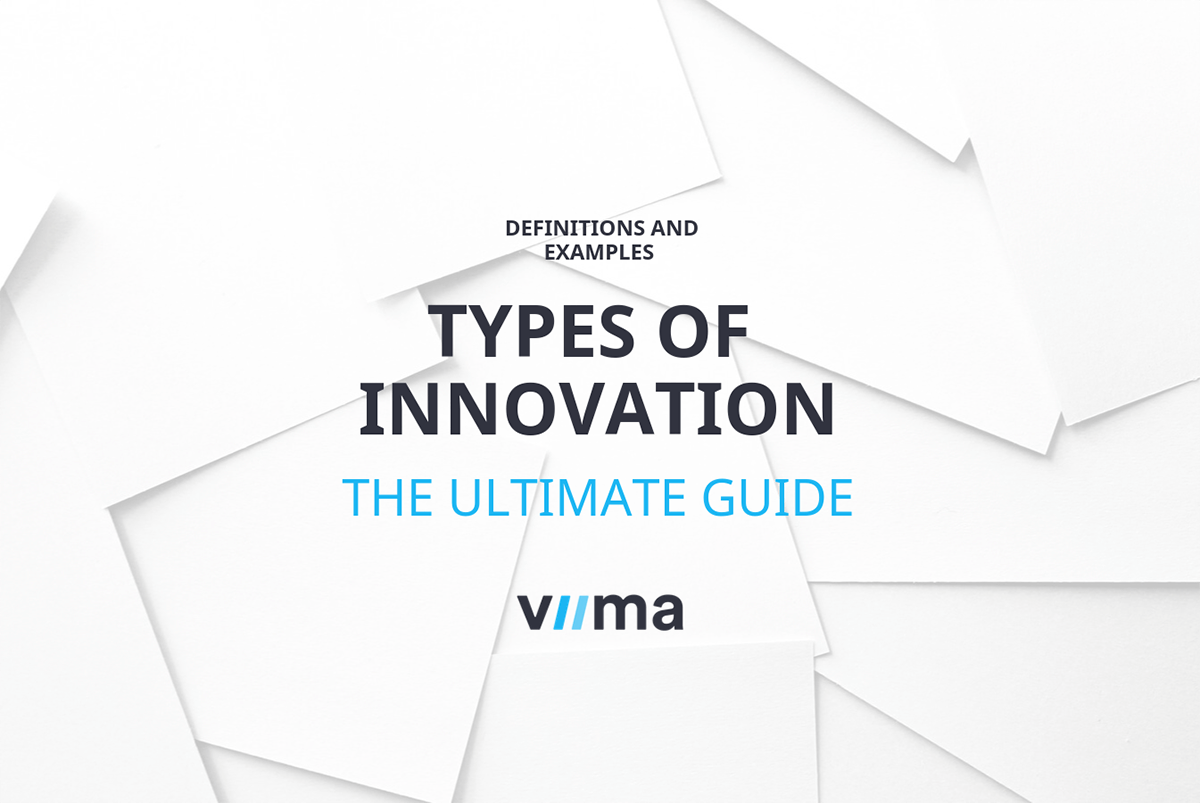Product Innovation – What is it and how to do it right
People talk about product innovation every day without even realizing it. Whether they refer to their smartwatch and its latest features, the top performing cars or the latest app that helps them unwind, they bring up product innovation.
But what makes these products innovative – and why are 95% of new products failing? How are some companies succeeding at bringing these innovations to the market and why others fail? Today, we’ll try to answer these questions and see what the factors contributing to successful product innovation are.

Table of contents
What is product innovation?
One of the more widely accepted definitions for innovation is the introduction of something new. That something could be anything from new services to products, processes and even incremental improvements to something that already exists. In practice, however, people usually refer to new or improved products when they talk about innovation.
But what, exactly, is product innovation? Product Innovation is probably the most famous type of innovation, and it can be defined in different ways. Without going through all possible definitions, let’s keep it simple and clear: product innovation is the development or improvement of products in a way that tries to solve problems for consumers, customers, companies or society at large.
Many such innovations can be tangible and involve either radically new technologies, or just incremental improvements of existing ones. But more on the types of product innovations later in this article.
Why more companies should consider product innovation?
We’ve seen time and again that innovation is the main economic driver, both for organizations and society at large. When it comes to product innovation, a McKinsey survey suggests that 25% of total revenue profits of a company come from the launch of new products.
A portfolio of good products drives growth and brings more profit, compared to services which can increase revenue but have a lower margin. There are several reasons for this. For instance, in many cases products are easier to scale than services. They are hands-off and easier to take care of. This is why the model of Service as a Product has been so successful. Airbnb, Uber, Fivers were able to scale and turn big profits. They don’t need close monitoring and interaction like other services would.
On the other hand, highly competitive markets made product innovation more difficult as more than 50% percent of new products fail to reach their targets. However, there are still plenty of compelling arguments in favour of product innovation.
1. Competitive advantage
Whether we talk about new products or improved ones, successful companies have always found a way to leverage innovation and gain competitive advantage.
Leading companies use product innovation to get ahead of their peers in three ways:
- Develop new products that answer the needs of their consumers or create new demand for them.
- Continuously improve on their core products and make incremental innovation their second nature.
- Redefine the competition by taking existing products to new channels or markets.
How does it look in practice?
 Redefining the competition is also about redefining the value of a product. For example, in the 70s, Japanese innovation almost took out of the market traditional watchmakers in Switzerland. Having low-cost production yet high accurate way of telling time, Swiss companies had to also redefine the value of their products.
Redefining the competition is also about redefining the value of a product. For example, in the 70s, Japanese innovation almost took out of the market traditional watchmakers in Switzerland. Having low-cost production yet high accurate way of telling time, Swiss companies had to also redefine the value of their products.
So Swatch took over a market once dominated by Japanese companies like Seiko or Casio. They repositioned themselves and created a fashionable line of swatches. Traditional watches also found a new market as the Swiss companies created the demand for luxury watches turned collectibles and long-term investments.
The sweet spot is balancing the three approaches: new products, improvements and targeting new markets. Focusing only on one of them is a mistake we see even in big companies.
The sweet spot is balancing the three approaches: new products, improvements and targeting new markets. Focusing only on one of them is a mistake we see even in big companies.
For example, in 2003 Lego ventured on new markets. Unfortunately, they lost focus and went on selling clothes, accessories and lifestyle products. After these failed experiments, they refocused on their core business and positioned themselves as leaders in toy construction kits. This focus enabled them to grow their revenue from €0.9 billion in 2004 to €4.8 billion in 2015.
Apple is also maintaining its competitive advantage through product innovation. Since the introduction of the smartphone in 2007, Apple has iterated on their innovation and initially gained market share and also took out of business slow to innovate competitors.
However, some caught up pretty fast and as we’ve seen in recent years, Apple lost market share in front of Samsung. In turn, they have grown by adding other products and services, like iCloud, Apple Music and different earbuds and headphones.
This takes us to the next argument in favour of product innovation.
2. Encourages resilience
It is common for companies that miss the innovation train and lag behind their competition to eventually disappear altogether. Product innovation is the chance to bounce back. If you create the right circumstances and strategize around this decision, product innovation can help you pivot.
Consider Nokia, a company famous for its numerous innovations and strategic pivots. They started as a wood pulp mill, then moved on to rubber boots and of course to their most recognizable products, the Nokia cell phones.
When Apple took the world by storm with their smartphones, Nokia was not able to catch up. They were close to bankruptcy but once they sold their cell phones business to Microsoft, they pivoted their business once more and turned to high-end networking and software products. This helped them in the past 10 years to increase their enterprise value 20 times.
However, Nokia phones haven’t died. They returned to the market in 2016. The Finnish company HMD bought the brand license to produce and sell Nokia phones and have recently launched six new models.
The complicated and complex story of Nokia perfectly depicts that the action you take on product innovation can make or break a company. It can easily become your worst enemy or the most powerful tool that keeps the business afloat and supports their growth.
3. Drives growth
Product innovation allows companies to grow, turn higher profits and conquer new markets. There are several contributing factors that enable growth and those that get product innovation right reap the benefits on a long term.
When the market is oversaturated and companies don’t find their way out, they could turn to product innovation. We’ll explain how this works when we get to the processes and frameworks, but in short, it is about creating new demand.
Three types of product innovation
Now that we have clarified what product innovation is, let’s have a brief look at the three main categories of product innovation.
1. Development of new products (NPD)
New products can fall under any type of innovation. They can be radical or disruptive, but usually they are actually incremental and sustaining by nature. We’ll explain a bit more in detail the NPD process later in this article.
Radical and disruptive innovations are not the most common and for good reason. They are harder to get right, they present more risks, and the success rate is not very high. The tricky part is not just coming up with ideas for new products, or even taking them to completion. The most difficult part is driving adoption of these products. And even if you’re successful, you still need to do all of that with manageable risks while keeping costs under control.
According to McKinsey only 1 in 7 ideas result in a successful product. This is why we can’t stress enough how important ideation and idea management are in developing new products. We have previously written about the key success factors in idea management, where we go into a bit more detail on how to go about this.
 Companies that have a great track record of launching successful new products use a systematic way of taking their ideas from concept to a marketable product.
Companies that have a great track record of launching successful new products use a systematic way of taking their ideas from concept to a marketable product.
2. Improvement of existing product or service
This type of product innovation is what we often refer to as incremental innovation. More specifically it refers to incremental changes aimed at improving existing products.
Improving on innovations developed by others is usually the most lucrative and successful type of product innovation. This happens because when new products are launched, they are usually not exploited to their full potential. A series of incremental innovations and improvements have to be made to better meet the needs of consumers.
Improving on innovations developed by others is usually the most lucrative and successful type of product innovation.
Take for example the computer. It was a new product when it has first appeared, a truly radical innovation. Several innovations and improvements in the technology made it possible to go from giant computers the size of a room to personal computers, and later laptops and smartphones. Innovations in computer hardware and software have made it possible to mass produce laptops at affordable prices.
3. New features to a product
Product improvement is the process of making significant and meaningful changes to products and this can also be done through new features. But new features can be just as risky as launching a new product.
What types of features are usually involved in product innovation?
Features are developed to improve products, increase frequency or increase adoption. As not all features will be appreciated, it’s important to decide what kind of feature is most relevant for your product and what goal it pursues.
If we consider feature creep, or scope creep, this is the perfect example of how features are not necessarily more valuable for customers. A HBR survey revealed that 56% of consumers who bought high tech-products feel overwhelmed and dissatisfied by the myriad of features they initially thought useful. Even more, investing in unnecessary features that are not strategic and don’t add value could mean throwing money down the drain, harming the product and even the brand.
What’s an example of feature creep in products? To make a coffee with the Bosch Benevenuto B30, you first have to choose from 12 options, decide on energy saving options, time programming and water hardness. It sounds a tad too much for a simple coffee. Consumers get overburden and all the additional features distract from the original usability of the product.
Product Innovation in Practice
Now that we clarified what is product innovation and what it implies, let’s see how it works in practice. For this, we’ll look at some of the most common strategies, frameworks and theories that make product innovation happen.
1. NPD – New Product Development
In a time when technology and communication channels are so easily accessible at large scale, anyone can make and launch products. The bar has been lowered, but not when it comes to good product development. Increased competition led to higher standards, so the bar is actually higher if you want to have a successful product on the market.
New Product Development, or NPD is the process through which companies take a product from concept to market. It can refer to completely new products or improvements of existing ones. Depending on industry or company, the process can, of course, be different.
We laid out below the most common seven stages new products normally go through. It starts with the ideation and concept generation and ends with the launch and introduction to the market. Keep in mind that these illustrate the most common approaches to NPD but they are by no means a silver bullet.

2. Continuous Improvement Processes
Just like NPD, this one is a high-level approach you should keep in mind as it involves a strategic, organization-wide process.
If you’re a regular reader, you are already familiar with continuous improvement as we’ve discussed this topic at length in other articles. However, we think it’s important to specifically mention the important role continuous improvement plays in product innovation.
If you embrace continuous improvement in your organization, it will only become natural to make better products and win that competitive advantage. As everyone involved in developing products is systematically engaged in doing a better job day after day, their strive for excellence will pay off on the long term. Constantly improving on your products will give you a steady advantage and you won’t be left behind.
There are many ways through which you can get there, and we also wrote about the continuous improvement processes and how to choose those that match your needs.

There are several continuous improvement processes and one we can mention briefly is the PDCA cycle (Plan, Do, Check, Act). This process supports the principles and practice of continuous improvement and Kaizen. Kaizen is actually the philosophy stemming from Japanese car manufacturers and is focused on making small changes every day to contribute to major improvements over time.
3. Blue Ocean Strategy
Blue Ocean Strategy is a theory developed by W. Chan Kim and Renée Mauborgne in their book with the same title. Their approach includes a set of tools and frameworks that enable companies to capture “blue oceans” which are the unexplored areas of the market.
It can be used to pursue differentiation, open up new market spaces and create new demand. The authors point out that fighting with competitors on a crowded market, the red oceans, is rarely a winning strategy, and by creating an uncontested market space for yourself, you are paving your way to success.
How does it look in practice?
Let’s take the example of Nintendo, a company lost in the red ocean of console games that couldn’t keep up with all the technological advances in the industry. Instead of giving up, they captured the attention of a new, more casual audience, drifting away from the hard-core gamers everyone in the industry had focused on for decades.
 Committed to new markets and to value innovation, they launched Nintendo Wii in 2006 and won over families and children. With a significant lower cost, a few novel features and a wireless motion control stick, they were back in the game. Their focus on value innovation was the winning strategy. However, to save costs and increase buyer value at the same time, they had to reimagine the market and redefine what quality means for their new segment.
Committed to new markets and to value innovation, they launched Nintendo Wii in 2006 and won over families and children. With a significant lower cost, a few novel features and a wireless motion control stick, they were back in the game. Their focus on value innovation was the winning strategy. However, to save costs and increase buyer value at the same time, they had to reimagine the market and redefine what quality means for their new segment.
4. Jobs to be done
You’re probably familiar with Jobs To Be Done, a framework for identifying customer needs. It’s all about finding out what kind of jobs consumers hire their products to do. However, there’s a bit more to it than just asking your customers the reasons for their choices. If you simply ask why they chose a certain product, you will rarely understand their needs in enough detail.
Going deeper, to the root causes of their choices, opens the door to real, value-adding innovation. These are the needs customers often didn’t even know they had. In an HBR article, Clayton Christensen explains how this framework works and why companies win with innovation once they understand how and why customers make certain decisions.
How does it look in practice?
Consider Nike, one of the best-selling athletic apparel and footwear companies to this day. When they first got started, they developed a product that performed a job that others had failed to get right. Nike co-founder, Bill Bowerman, originally a track and field coach set on a mission to help athletes run faster. His interest in making shoes perform the job athletes needed done led to the invention of top Nike shoe brands like Cortez or Waffle Racer. Nike switched from distributing other footwear brands to creating their own.
It’s important to look at products through the lens of jobs to be done because it can broaden your business horizons and help you identify new opportunities that others haven’t already tackled.
How to do product innovation right?
Leading companies have a balanced portfolio that mixes niche products, entirely new developments and improved products. Their key to success, as reported by McKinsey seems to be in their systematic approach to product innovation, that includes a closely monitored and tracked strategic process as well as great collaboration and implementation capabilities.
McKinsey identified in their analysis four major factors that contribute to the success of product development. However, these are not necessarily the same for every organization, so try to identify the capabilities you need for the kind of product innovation you’re doing. Regardless, here are four you might want to consider.
- Collaboration
The ability to manage and unite teams towards a specific goal is essential for any type of innovation. It’s a myth that innovation is a solo activity. Some people can be better at ideation when they are on their own, but making innovation happen requires more brain power as well as diverse talent capable of performing different kind of tasks required to create and deliver great products to the market.
 Strategy and planning. This step is often underestimated by many companies as they want to fast forward to the development or testing phases. Product innovation requires excellence in strategy and planning because there is so much work in preparing a truly innovative product. Plans should be thorough, and they should include different scenarios that assess and mitigate risks.
Strategy and planning. This step is often underestimated by many companies as they want to fast forward to the development or testing phases. Product innovation requires excellence in strategy and planning because there is so much work in preparing a truly innovative product. Plans should be thorough, and they should include different scenarios that assess and mitigate risks.
It’s not to say that you should linger on the strategic phase for too long. If you find yourself stuck in this phase, by the time you are ready to act, it might already be too late. It’s important to get the big picture right, decide which direction is right for you and then be fast and agile in testing, learning and adapting on the way.
Thorough analysis of the market. Before getting to the drawing board, you need to do your research. What’s the demographic like, what needs is your product answering and what differentiates you from the competition? Think here at the jobs to be done theory and the blue ocean framework.
As previously mentioned, don’t get stuck here for too long. If you are not up to speed, your research might be in vain. So once again, be flexible about your plan and revise things as you move ahead.
- Training teams in charge of launching products
Speaking of the capabilities of your workforce, we’ll state the obvious, that you need to get the best people for the job. They are crucial for the success of your product innovation.
Once you have the right people keep in mind that for innovation to happen, teams should be trained to strive for excellence. This is of course more complex, and it requires a certain environment that allows an innovation culture to flourish. Successful companies know that investing in training and developing their people will add to the outcome of the product.
To this, it’s worth adding some more specific product related factors that can have an impact on the final result:
- Compelling value proposition
This is probably the single most common failure companies may go through in the process and it takes us back to the jobs that customers need done. Your value proposition is what sets you apart. It should be clear how your product is providing a solution to specific customer needs. All too often companies just create cool gadgets that don’t really add value to anyone.
- Low friction
For products to be adopted at a large scale, they have to be straightforward, easy to understand, and easy to use.
- Product portfolio integration
Deciding on the next product or improvements should always be consistent with the big picture goals and strategy of your organization. Are these innovation initiatives taking you in the right direction and contributing to a balanced product portfolio?
Examples of product innovation done right
1. Sony
From the way we listen to music, to digital cameras and big TVs, to dog robots, Sony has been a trailblazer in innovation for the past 60 years.
Today, gaming is the most profitable industry in the entertainment sector. As HBS reports, when Sony entered the market, the real gaming war began. The PlayStation release in 1994 turned Sony into the biggest rival of Nintendo and Sega, companies dominating the gaming industry until then.
Sony launched on the market innovations that placed them ahead of their competitors. The key differences in the PlayStation were CD-ROMs used to process the games and the introduction of 3D graphics. At that time, they were technologically superior and more attractive for developers who could create a wider variety of games.
 Sony also excelled at identifying their competitors’ weaknesses and at delivering great value to their customers. They were able to price their console lower and attract more players on their side.
Sony also excelled at identifying their competitors’ weaknesses and at delivering great value to their customers. They were able to price their console lower and attract more players on their side.
There are several factors that contributed to their success and whether it was the technology, the pricing or their timing, Sony knew how to use innovation to fuel their growth.
2. Beyond Meat
Beyond Meat is driven by their philosophy to continuously improve and their approach to innovation placed them in top 50 most innovative companies. In an oversaturated market, what differentiates Beyond Meat? Instead of going only after vegans and vegetarians, Beyond Meat were among the first to target omnivores and people who want to reduce meat consumption. This was a good switch since targeting exclusively vegans would mean going out on a very small, niche market.
Since their launch, the competition grew fiercer and there are countless alternatives out there. However, it’s worth mentioning their role in changing the market and their dedication to innovation as their main ingredient to becoming the dominant global protein company.
Beyond Meat states their commitment to innovation through continuous improvement and the use of latest technologies. While they were trailblazers at first, it won't be easy to maintain this position on such a crowded market. If they want to continue growing and surpass their competitors, they definitely have to up their innovation game.
3. Tesla
Tesla is the name we always come back to when we talk innovation. They didn’t invent electric vehicles, but their innovation lies in improving the technology that converts more and more people to electric cars. Tesla is innovating to increase battery longevity, decrease costs for consumers and increase value on the market.
Beyond technological innovations, Tesla is always the poster child of innovation because of their ambition to become better at everything they do. They have reimagined big parts of the value chain at a rapid pace and recently also achieved a 96 Net Promoter Score (NPS), by far the highest in their industry.
The challenges of product innovation
There is no product scarcity today, which makes product innovation a risky business. Every company is trying to come up with new or improved products and they are facing numerous challenges. We listed below some of the most common challenges facing product innovation and some possible workarounds that you might find useful.
1. Proving product viability
Product viability refers to the business potential of a specific product. Unfortunately, many companies miss this as they fail to create relevant products that really answer to customer needs.
To overcome this challenge, always ask yourself if there is demand for your product, if it provides a solution to a problem and if it does, can you sell it at a competitive price which allows for ROS (return on sale)?
Sometimes it’s not enough to just ask yourself as your biases might hinder your judgment. Go further and look into the jobs to be done theory and make sure your product is performing a job customers need done. Research the market thoroughly and get as much insights as possible and remember that you can’t do it at your desk. You have to get your hands dirty and go on the field.
2. High costs
There are two types of cost challenges that can arise in a company.
First, you might have a product that costs too much to produce so your profit margin will be low, or you end up losing money. It’s best to focus on what really creates value and what ads to the costs on the long run. Jobs To Be Done and Blue Ocean Strategy are frameworks that will help you focus on providing value and decrease production costs.
Secondly, the development costs which you can’t recover if you’re not able to get a high enough profit margin, or wide enough adoption for the product. A way to get around these development issues is to be agile, learn from failures and have a fast pace of innovation.
MIT Sloan has documented how eight different Japanese companies develop profitable new products. Successful Japanese companies like Toyota, Olympus, Sony or Nissan focus on highly structured processes and manage costs early in a product’s life. In their analysis they also emphasise the importance of disciplined proactive cost management in the product development process.
3. Pricing
Putting the right price to innovation is always challenging and it’s especially true with consumer goods. Pricing can tip the balance in your favour and determine more people to buy your products. You might have an awesome product but if no one wants to buy it you’ll find yourself in a tight spot.
Pricing is a very powerful tool to determine the feasibility of innovation early on. We invited Kyle Westra in the Innovation Room Podcast to talk about pricing innovation and new product development. He explained in detail the pricing process and how involving pricing early on in the innovation process and product development can put you ahead of the competition.
4. Innovation for the sake of innovation
When innovation is merely a branding strategy and is not purposeful, companies get in trouble. Innovation for the sake of innovation could occur when companies want to show results to internal stakeholders. Such initiatives can be highly visible, but they are not always aligned with a comprehensive enterprise-wide innovation strategy. This is known as the theatre of innovation.
If you realize that you’re in that bucket, take a step back and focus on incremental innovations for a little while. Large companies have the advantage of getting tons of support requests, customer complaints and improvement suggestions from customers, employees and pretty much every other stakeholder too.
Simply put, identifying and understanding customers’ pain points can lead to major opportunities for improvement. Once you have understood the extent of these pain points it’s important to address them as opportunities for innovation, not as ways of mitigating damage.
 We can think of the Haier example from 1996 when consumers were complaining their washing machine hose was clogging. As it turns out many people in rural areas were having the same issue because they were using washing machines to wash sweet potatoes. Haier enhanced their product to meet such needs in rural areas and the first 10,000 washing machines sold out immediately.
We can think of the Haier example from 1996 when consumers were complaining their washing machine hose was clogging. As it turns out many people in rural areas were having the same issue because they were using washing machines to wash sweet potatoes. Haier enhanced their product to meet such needs in rural areas and the first 10,000 washing machines sold out immediately.
Of course, this can't count as the most radical innovation out there, but it shows how products can be improved by answering customers' pains.
Identifying and understanding customers’ pain points can lead to major opportunities for improvement. Once you have understood the extend of these pain points it’s important to address them as opportunities for innovation, not as ways of mitigating damage.
5. Complexity
The focus on product improvement can also be taken too far. When this happens, improvements have the opposite effect and innovation initiatives backfire. Feature creep illustrates this perfectly. Feature creep happens when excessive expansion or features are added to products. It mostly happens with computer software and consumer and business electronics.
Usually, incremental new features to an existing product add slightly less value than the previous one, and before long, you may be in a position where each new feature costs more than it adds in value. What’s more, every new feature adds complexity, and complexity slows you down and makes additional development harder still.
So, keep it simple. The best products are always elegantly simple, and simplicity might just be the hardest thing to achieve. To prevent counter effects, always base your decisions on data. Perform tests, validate your ideas and don’t be afraid to go back to the drawing board.
Conclusion
To wrap things up, we want to remind you that investing in all forms of product innovation brings huge benefits for large companies. It allows you to stay in business and gain advantage in a highly competitive market and enables your growth and long-term success.
It’s also good to keep in mind that once you’ve aligned your goals and strategy, you need a fast pace of innovation to keep up with markets that have become oversaturated with products, consumer goods and new technologies.
Consider a holistic approach to product innovation. This includes a culture of innovation, incremental improvements as second nature as well as a varied and balanced product portfolio.
We know product innovation is not a walk in the park, but with hard work and commitment you can get better at it. There are also other types of innovation you can look into and plenty of resources we provide for those who want to make more innovation happen in their organization. For an in-depth look at the types of innovation and how to make it happen, download our ultimate guide to innovation.








